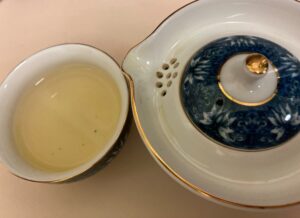Green tea lovers should make room in the pantry for Teavivre’s Chun Ya. Whether brewed traditionally or using the gongfu (multiple steeps) method, this one’s a real treat.
You might think the strong, sweet, floral, nutty aroma would render a bitter taste, but you’d be wrong. The full body of this tea — which holds up after multiple steeps — is smooth and buttery.
The floral, nutty taste of the first steep or two continues to enchant the taste buds well after the fact. Subsequent steeps are sweet, apple-pear-like, and subdued but no less satisfying.
Teavivre sources its Chun Ya green tea from the Sichuan Province of China and harvests it in early spring. Relatively inexpensive and low in caffeine content, it’s a great choice for daily afternoon consumption.
Video Transcript
[Presenter looking confused. Second Cuppa log appears]
Join me today, and I’m going to show you how I brew using the gongfu method.
That’s multiple steeps, more tea, shorter infusions …
I’m going to show you how I do it.
Let’s get started.
Okay so, I don’t have a fancy gongfu set like you might see in other YouTube videos.
But I do have what’s needed.
I have this teacup.
I have this gaiwan.
And, really the gongfu method means you’re doing multiple steeps.
You want to do this when you have a quality tea, be it a pu-erh or a green tea or whatever nice tea that you have.
If you can get multiple steeps out of it, and you have time to enjoy it that way, then why not?
So, I’m going to show you how I do it.
And the first thing I’m going to do is warm up all my tea accessories.
I’m just going to warm my gaiwan and my teacup as well.
[Warming the teapot and accessories maximizes heat retention, optimizing the tea leaf infusion]
I’m just going to let them hang out with this warm water for a while.
[percussive music]
[Measuring out 4 grams of tea]
I am brewing the water to a temperature of 185° Fahrenheit,
which is good for green tea.
[Rinse the tea leaves; Temperature: 185° Fahrenheit; Time: 15 seconds]
[Footage of the presenter steeping tea at 5 to 7 times normal speed]
[First steep; Temperature: 185° Fahrenheit; Time: 20 seconds]
[raises the teacup with a light green liquor to the camera]
[Second steep; Temperature: 185° Fahrenheit; Time: 30 seconds]
[raises the teacup to the camera again]
[Third steep; Temperature: 185° Fahrenheit; Time: 50 seconds]
[raises the teacup with the results of the third steep (an even lighter green) up to the camera]
[Fourth steep; Temperature: 185° Fahrenheit; Time: 70 seconds]
[Second Cuppa logo appears]
[pours the fourth steep into the teacup (very light green in color) for the final time]
[frame freezes to a still image of presenter holding the teacup up to the camera]
[Thanks for watching!]

